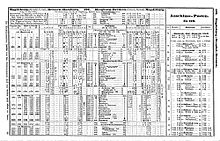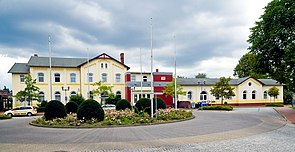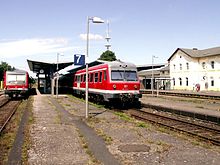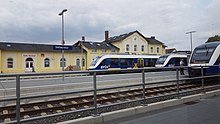Soltau (Han) station
| Soltau (Han) | |
|---|---|
|
Entrance building, street side
|
|
| Data | |
| Operating point type | railway station |
| Location in the network | Crossing station |
| Platform tracks | 4th |
| abbreviation | HSO |
| IBNR | 8000088 |
| Price range | 5 |
| opening | 1873 |
| Profile on Bahnhof.de | Soltau__Han_ |
| location | |
| City / municipality | Soltau |
| country | Lower Saxony |
| Country | Germany |
| Coordinates | 52 ° 58 '59 " N , 9 ° 49' 46" E |
| Railway lines | |
|
|
| Railway stations in Lower Saxony | |
The Soltau (Han) train station is a train station in the Lower Saxony city of Soltau , centrally located in the Lüneburg Heath . As a crossing station on the two railway lines Hannover Hbf - Buchholz ( Heidebahn ) and Bremen Hbf - Uelzen ( Amerikalinie ) , it is a central traffic junction in the region and serves as an important destination and transfer station for commuters and visitors to Lüneburg Heath.
The station, which opened in 1873, offered travel options in seven different directions for local and long-distance traffic in the mid-20th century. The American line , which ran from Berlin via Soltau to Bremerhaven , was of great importance for passenger traffic and goods transport from the ports of the North Sea at the end of the 19th and beginning of the 20th century. Express trains also ran on this route back then . In addition, there was a connection to several small railways to Lüneburg , Celle and Neuenkirchen . After the Second World War , the American line increasingly lost its national importance. Passenger traffic on the small rail lines has now been discontinued.
history
Difficult start and climb to the junction

Despite its geographically favorable location in the triangle between the major cities of Hamburg , Hanover and Bremen , Soltau was not taken into account at the beginning of the railway development in the Kingdom of Hanover in the 1840s. Because of the greater importance of Lüneburg , the route Hanover - Hamburg , which was opened in 1847, was not chosen to be a direct connection via Soltau, but rather a detour via Lüneburg and Celle .
After the annexation of the Kingdom of Hanover by the Prussians in 1866, the capital Berlin was to be connected to the ports on the North Sea by the shortest possible route. This economic connection Bremen - Berlin led through Soltau. A “second class” train station was then planned in the city. Because of the better connection to the main road (today's Bundesstraße 3 ), the state commission preferred a location east of today's Celler Straße. At the request of the city of Soltau, however, the station was built near Walsroder Straße within just three years. The Hanseatic City of Bremen took over the costs for the construction . On August 1, 1873, the station and line were sold to the Prussian state. The Uelzen - Langwedel line as a section of the connection between Berlin and Bremen was opened on April 15, 1873 for freight and on May 15, 1873 for passenger traffic. Until 1886 the Magdeburg-Halberstädter Railway Company ran the business on behalf of the Bremen State Railway , after which the Hanover Railway Directorate of the Prussian State Railway took over the administration. A quote from the Böhme-Zeitung from August 25, 1871 shows the great importance that the connection of the small town to the railway network had: “Soltau [...] a town more than 2nd rank, [...] is suddenly becoming a new one discovered fixed star are noticeable and recognized among the stars ”. The station was given the suffix (Han) , which should make the location in the province of Hanover clear and which still exists today.
The further development of the Lüneburg Heath never had top priority and so the planning for it was repeatedly postponed. In 1881 a direct connection from Hanover via Walsrode and Soltau was discussed for the first time . However, the Fallingbostel office rejected an application from Hanover for financial reasons. The plans changed several times over the next few years and in 1890 the Hanover - Walsrode line was finally no longer led to Soltau, but initially in the direction of Visselhövede . Because it was mainly the citizens of Fallingbostel who wanted a connection between Walsrode and Soltau, it finally came about and was opened on September 30, 1896. From the beginning, four pairs of trains drove on the Walsrode - Soltau route, three of which passed through to and from Hanover. The travel time from Soltau to Hanover was more than three hours.
On October 1, 1901, a connection from Soltau to Buchholz in the north heath, i.e. in the direction of Hamburg, was opened, thus completing what is now known as the Heidebahn . The journey from Hamburg to Soltau took just under four hours - also due to a longer stay and sometimes a necessary change in Buchholz. Soltau had become a railway junction from which journeys in all four directions were possible.
At the neighboring small train station Soltau Süd there was also an option to change trains to the small railway lines Celle - Soltau (from 1910), Lüneburg - Soltau (from 1913) and Soltau - Neuenkirchen (from 1920).
In the 1920s, express trains also ran on the Heidebahn, which only stopped at the main stations and, for example, reduced the travel time from Hanover to Soltau to less than two hours. On October 2, 1932, the permissible speed was increased to 60 km / h. In the 1930s, thousands of day trippers from the cities of Hanover , Altona and Harburg took the train to the heath , especially on Sundays and public holidays . The importance of the Soltau train station was also evident in its external appearance, such as the reception building with its numerous auxiliary buildings and signal boxes and the length of the main tracks.
The most important route was the main line Uelzen - Langwedel, which was also called the American line because of the emigrants to America who used it . On this route, some express trains also stopped at the Soltau station. In 1939, for example, the timetable showed the three D trains Berlin - Norddeich (D 102), Berlin - Wilhelmshaven (D 106) and Berlin - Bremen (D 108).
The Soltau train station in the time of National Socialism
The Soltau (Han) Station played in the time of National Socialism a tragic role in the transports of prisoners into the supply and interchange station concentration camp Neuengamme and Bergen-Belsen , and eastwards to the Sobibor extermination camp and after Auschwitz . At the Reichsbahnhof, the National Socialist People's Welfare operated a soup kitchen and there was a hospital barracks .
While normal passenger trains, declared as special trains with many “travelers” from the Netherlands, stopped in Soltau from around 1942, the misery of the prisoners became more and more evident, especially shortly before the end of the war. In 1945 thousands of concentration camp prisoners were crammed into cattle wagons and transported through the stations along the Heidebahn. Over 600 people died on the route between Buchholz and Soltau.
From February 22, 1945, there were air raids on the Soltau train station. On April 11, 1945 the tracks were interrupted so that no train journeys were possible. The long concentration camp trains stopped in the open. In the Oeninger Forest, some prisoners fled and set off in the direction of Soltau. Some people from Soltau supported the refugees with food and clothing, but members of the Wehrmacht , the SS and the local Hitler Youth hunted down the escaped people together with some Soltau citizens. They rounded them up and killed a total of more than a hundred people, mostly on the spot.
Development after the Second World War
The connection Berlin - Soltau (- Bremen) was cut after the Second World War by the zone border and lost its national importance. Even after reunification and the closing of the gap to Salzwedel , the American line remained a single-track branch line.
From the 1950s to the 1970s, continuous express trains ran on the Heidebahn from Hamburg-Altona via Hanover to Altenbeken through Soltau. After that they ended in Hanover. Since the 1980s, only local trains have run in the direction of Hamburg, most of which ended in Buchholz, where you had to change trains. Express trains ran in the direction of Hanover until the 1990s and were later converted into regional trains.
From 1961 the passenger trains from Lüneburg and Celle , which had previously ended at the small train station Soltau Süd , served the Soltau (Han) train station directly to make it easier to change trains. The Soltau Süd station was closed to passenger traffic. A change of direction (a so-called head turning ) would have been necessary to run the trains from and to Neuenkirchen to the Bundesbahnhof - instead, passenger traffic on this route was finally stopped on May 28, 1961. On May 30, 1975, passenger traffic between Bergen and Celle was also discontinued, and from May 21, 1977 passenger trains no longer ran on the Lüneburg - Soltau route. Since then, freight trains have been running almost exclusively on the two routes that serve the Soltau (Han) Süd freight yard .
In 1969 the speed limit on the Hanover - Buchholz route was increased to 80 km / h. From 1978 onwards there were repeated considerations to shut down the branch line, but this led to protests. The Rettet die Heidebahn association was founded in 1984 and in the following years carried out more than 70 special trips with a total of 35,000 passengers. In 1989, after modernization, celebrations for the inauguration of the so-called New Heidebahn took place in Soltau . Numerous special trains also ran on the Heidebahn route and through Soltau in the 1990s, for example in 1994 there were trips to Bad Segeberg , Westerland , Cologne or the island of Rügen .
On February 1, 1995, a DB class 628 railcar derailed during a shunting run in Soltau (Han) station, it was towed away the following day and taken to Kiel .
Current planning and modernization
From 2005 a memorial in memory of the prisoners from the concentration camp trains murdered in 1945 was discussed, which was originally supposed to be located directly at the train station. The discussion about the memorial and its location, in particular an online vote by the Böhme-Zeitung , in which the majority of the participants spoke out against the memorial after a call in a right-wing extremist forum, caused a national sensation. It was finally erected in 2007 near the killing site in the Siberian Forest from model steles from the Berlin Holocaust memorial . The choice of the somewhat remote location on the outskirts instead of the more central train station also caused criticism. At the beginning of November 2009 the train of remembrance stopped at the Soltau train station.
In autumn 2010 the platforms were completely renovated and dynamic text displays were installed. A new, modern ticket machine was installed in February of the same year.
In December 2011, the railway company erixx took over operations on the Hanover - Buchholz and Uelzen - Bremen routes, the so-called Heidekreuz, from DB Regio .
From mid-2013, the Lower Saxony Ministry of Transport examined the reactivation of numerous routes for passenger traffic. Of the original 74 railway lines, the OHE line from Soltau to Lüneburg reached the round of the last eight and was thus in the running for a restart until the end. In the final decision in early 2015, however, it was not one of the three reactivated routes due to the high costs. The routes from Soltau to Celle or Winsen (Luhe) were eliminated in the second selection round.
For a long time there were neither escalators nor elevators at Soltau railway station, but only an underpass, so that it was very difficult for wheelchair users or passengers with prams, bicycles or heavy luggage to reach all tracks. For a long time, many used a crossing over the tracks that was only intended for railway employees. After Deutsche Bahn removed this crossing in 2012, there was a dispute between the city and the railway, with the former even threatening to file a lawsuit. The railway stuck to its plan to make the Soltau train station accessible from 2015/2016 as part of the Heidebahn modernization . After further delays, the elevators were finally put into operation in June 2017; the new pedestrian tunnel had already been completed beforehand. As part of this modernization, which has been running since 2008 and is expected to be completed in 2018, the maximum speed will be increased to 120 km / h on the entire route, which will reduce the travel time from Hanover to Buchholz by around half an hour.
A modernization and electrification of the American line is under discussion in order to make the route more attractive, especially for freight traffic. The American line to be expanded is also being discussed as an alternative to the planned Y-route , which could become a burden, especially for the route in the Soltau urban area, and is already leading to protests from residents.
Buildings and plants
Reception building
The representative reception building is multi-storey and has a total area of 1770 m² , the associated property is 934 m².
In the 1960s, the station building was given a porch and was painted in color. The apartments in the building are empty, the train station restaurant and baggage counter have long been closed. In the building there is only a lounge and a kiosk with ticket sales. In 2004 the station was renovated for around 350,000 euros. The station building was repainted, and benches and showcases were installed. The tunnel underpass was cleaned and painted. In September 2008 and March 2009, one wall of the tunnel underpass was decorated by students from Soltau with pictures of the city and the theme of the Game Foundation .
On April 4, 2014, Deutsche Bahn sold the Soltau station building to a private individual for 72,000 euros. The lounge and kiosk will remain open after the sale, nothing is known about the planned future use of the building.
Signal boxes and outbuildings
The station has three mechanical interlockings of the unit design from 1935, which are still in operation: the dispatcher interlocking Smf and the two switchman interlockings So and Sw . The former express goods shed is connected to the reception building.
A goods shed used to be attached to the building and there was also a locomotive station . To the east there were two toilet buildings (lavatories), two stables and a lounge. On the south side were the locomotive station facilities with a four-tier shed, coal store, oil store and bathing establishment. The railway maintenance office was west of the ramps on the loading road.
The Soltau train station has changed little over time. Some outbuildings were demolished and there is now a bus station. The local SPD has set up in the express goods shed and has set up a workshop for the disabled in the railway depot.
Track systems and platforms
The Soltau train station has three platforms that are connected to each other via a pedestrian tunnel. Four tracks can be used for passenger traffic. The house platform allows access to platform 1 (Uelzen – Langwedel route), there is also a central platform for platforms 2 (Langwedel - Uelzen) and 5 EAST (Buchholz - Walsrode / Langwedel) as well as an intermediate platform at platform 7 (Langwedel / Walsrode - Buchholz ).
Track 3 is used as a storage and pull-out track in the direction of Langwedel and track 4 for freight train traffic. Track 6 and track section 5 WES are still used by Deutsche Bahn as siding. There are also additional sidings.
traffic
passenger traffic
Currently (as of 2019) only the Heidebahn and the Amerikalinie in passenger traffic are served at the Soltau (Han) station. The two routes are operated by the private railway company erixx . The Heidebahn from Hanover to Buchholz mostly runs every hour, the Uelzen - Bremen route is usually served every two hours. On weekends, the Heidebahn has been running to Hamburg-Harburg since December 2018 .
| line | route | Line course | KBS | vehicles |
|---|---|---|---|---|
| RB37 | Amerikalinie / Uelzener Bahn | Bremen Hbf - Langwedel - Soltau (Han) - Munster - Uelzen | 116 | LINT 41 |
| RB38 | Heidebahn | Hanover Central Station - Walsrode - Soltau (Han) - Schneverdingen - Buchholz (Nordheide) - ( Hamburg-Harburg ) | 123 | LINT 41 |
In terms of passenger traffic, the Soltau train station is mainly important for commuters, schoolchildren and day-trippers to Heide-Park , the Soltau-Therme or the Designer Outlet Soltau . According to railway information, 1237 people use the station as a destination and transfer station every day (as of November 2013). Soltau station has been part of the HVV area for season tickets since January 1, 2008 . Admission to the GVH is also planned.
Occasionally, individual museum train rides are still on the routes of the OHE to Lüneburg and Celle , e.g. B. with the Heide-Express of the Arbeitsgemeinschaft Verkehrsfreunde Lüneburg e. V. offered. In addition, the “anteater”, a historic Hanover-type rail bus from 1937 , travels from Soltau via Bispingen to Döhle in the summer .
Freight transport
The freight transport facilities were in the northwest part of the station. They are no longer in use. Some buildings have been preserved, but now have no siding and are no longer owned by Deutsche Bahn. They are used commercially. The street name Am Güterbahnhof is a reminder of the earlier use. The Soltau (Han) station itself is usually no longer used for freight traffic; the OHE's Soltau Süd freight station, which is only a few hundred meters away and to which there is a rail link, serves this purpose . The station is therefore mainly affected by through traffic.
Bus transport
There is a bus stop directly in front of the train station for connections to public transport . Nine bus lines of the Verkehrsgemeinschaft Nordost-Niedersachsen (VNN) connect the station with the surrounding towns of Schneverdingen (line 106), Bispingen (154), Neuenkirchen (205), Munster (305) or Wietzendorf (355) and the districts of Soltau . Special lines to Heide Park and the Designer Outlet Soltau are also offered.
Numerous tour operators also use the Soltau (Han) train station as a destination. Until April 2014, the station was the stop of the daily long-distance bus route Cuxhaven- Berlin of the Berlin-Linien-Bus- Gesellschaft.
literature
- Erich Preuss (ed.): The large archive of the German railway stations . Loose-leaf collection, 5 volumes, GeraNova Zeitschriftenverlag, Munich 1995–2010.
- Wolfgang Bargmann : The city of Soltau in the history of Lower Saxony. Volume II: From the Thirty Years War to the end of the First World War, 1620 to 1919 . 2005, ISBN 3-933802-14-8 .
- Dierk Lawrenz, Lothar Eichmann: The Heidebahn - From Buchholz via Schneverdingen to Soltau. 85 years through the Lüneburg Heath . 2nd Edition. EK-Verlag, Freiburg 1997, ISBN 3-88255-419-3 .
- Uwe Nordhoff, Reinhard Otto u. a .: Only the Lord God knows their names. Concentration camp trains on the Heidebahn . Verlag Schulze, Soltau 1991, ISBN 3-927594-12-1 ( online at: www.kz-zuege.de ).
Web links
- Historical and current images of the Soltau (Han) train station
- Tracks in service facilities (HSO) , DB Netz AG (PDF) - Track plan of Soltau station (Han)
- heidekreuz.de - Information about the Heidebahn and the American line
Individual evidence
- ↑ a b c d e f g h i j k l m n o p Soltau station (Han) . In: Erich Preuß (ed.): The large archive of German train stations . Loose-leaf collection, 5 volumes. GeraNova Zeitschriftenverlag, Munich, p. 1-4 (1995-2010).
- ↑ a b c d e Wolfgang Bargmann : From the Thirty Years' War to the end of the First World War 1620 to 1919 (= The city of Soltau in the history of Lower Saxony . Volume 2 ). 2005, ISBN 3-933802-14-8 , The New Infrastructure, pp. 152-172 .
- ↑ Wolfgang Brandes: Lecture on the history of the Walsrode – Soltau line, part 12. In: heidekreuz.de. September 26, 1996, accessed September 3, 2015 .
- ↑ Wolfgang Brandes: Lecture on the history of the Walsrode – Soltau line, part 14. In: heidekreuz.de. September 26, 1996, accessed September 3, 2015 .
- ↑ Timetable of the Kleinbahn Lüneburg – Soltau from May 15, 1935. In: kdtroeger.de. Retrieved September 21, 2015 .
- ↑ Friederike Fricke, Fallingbostel: Niedersachsen, 28th year 1923. pp. 129–141 , accessed on September 21, 2015 .
- ^ A b Wolfgang Brandes: Lecture on the history of the Walsrode – Soltau line, part 15. In: heidekreuz.de. September 26, 1996, accessed September 3, 2015 .
- ↑ a b c Uwe Nordhoff, Reinhard Otto, u. a: Only the Lord God knows their names. Concentration camp trains on the Heidebahn . Verlag Schulze, Soltau 1991, ISBN 3-927594-12-1 , chap. 11 ( Available online. ).
- ↑ various course books
- ↑ a b Chronicle of the Heidebahn. In: heidekreuz.de. Retrieved September 21, 2015 .
- ↑ Holger Dambeck: Online vote: Soltau does not want a memorial for Nazi victims. Spiegel Online , February 7, 2005, accessed September 25, 2015 .
- ↑ Soltau memorial commemorates victims of the Nazi terror. Die Welt , April 10, 2007, accessed September 25, 2015 .
- ↑ Guessing the forest. The daily newspaper , April 12, 2007, accessed on September 25, 2015 .
- ↑ Information on "reactivation of railway lines". Lower Saxony Ministry of Economics, Labor and Transport, accessed on September 21, 2015 .
- ↑ When will Soltau train station be barrier-free? In: ndr.de. August 22, 2012. Retrieved August 22, 2012 .
- ↑ Klingbeil: Bahn finally puts elevator in Soltau into operation. In: lars-klingbeil.de. June 29, 2017. Retrieved February 21, 2018 .
- ↑ No unsympathetic expansion of the American line. (No longer available online.) Archived from the original on March 5, 2016 ; Retrieved on September 21, 2015 (information on the planned expansion of the American line on the pages of the Unsynn action alliance ). Info: The archive link was inserted automatically and has not yet been checked. Please check the original and archive link according to the instructions and then remove this notice.
- ↑ a b Soltauer Bahnhof is for sale . In: Böhme newspaper . November 26, 2013, p. 3 .
- ↑ Station underpass in Soltau embellished with pictures. In: bahnaktuell.net. March 22, 2009, accessed September 21, 2015 .
- ↑ Soltau train station: The hammer falls at 72,000 euros . In: Böhme newspaper . April 5, 2014, p. 3 .
- ↑ Signal box infrastructure on the Heidebahn. In: heidekreuz.de. September 8, 2009, accessed September 21, 2015 .
- ↑ Tracks in service facilities of DB Netz AG - Soltau (Han). (PDF) In: dbnetze.com. Retrieved September 21, 2015 .
- ↑ HVV tariff for season tickets from Soltau / Schneverdingen. HVV, accessed on September 21, 2015 .
- ↑ Timetables Heidekreis. (No longer available online.) In: vnn.de. Archived from the original on September 3, 2015 ; accessed on September 21, 2015 .
- ↑ Berlin public bus goes on a farewell tour . In: Böhme newspaper . April 1, 2014, p. 5 .












